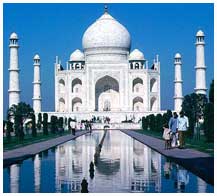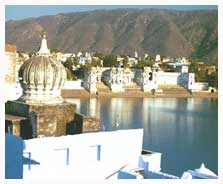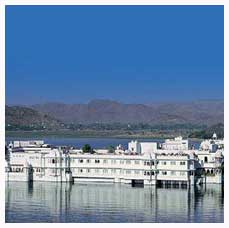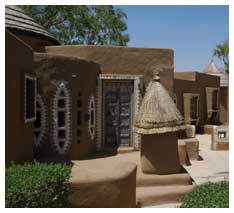Delhi - Agra - Jaipur - Pushkar - Udaipur - Jodhpur - Jaisalmer - Bikaner - Mandwa - Delhi
14 Nights and 15 Days
| Day 01: Arrival in Delhi |
| Arrival at Delhi International airport by flight. Go legacy India Journeys and our ambassador will welcome you to Golden Triangle Tour at the Delhi International Airport and escort you to the hotel. Meeting and assistance on arrival at the airport, our representatives receive and attend you by a private car and convey to the hotel. Overnight at the hotel. |
Delhi |
|
The Indian capital city of Delhi has a long history, include a history as the capital of several empires. It is one of India's main rising cities. Delhi has a strong historical background, due to the fact that it was ruled over by some of the most powerful emperors in Indian history. Delhi, has seen the increase and fall of many empires which have left behind an excess of monuments that the majesty and splendor of future ages. |
| Day 02: Delhi |
|
|
After the morning breakfast at your hotel, take sightseeing tour of historic Delhi visiting Jama Masjid; the biggest Mosque in India, The next place to visit is the Qutub Minar which is close to the mosqueRajghat Memorial of Mahatma Gandhi and rickshaw ride past through the silver street in Chandani Chowk, Afternoon visit Qutub Minar built by Qutub-ud-Din Aibek in 1199, Humayun's Tomb, India Gate (War Memorial Arch ), Lakshminarayan Temple - a contemporary Hindu Temple and in the evening you visit to Red fort. ReReturn to the hotel for overnight stay. |
| Light & Sound Show |
This is the evening show which recreates the Indian history which is linked with the Red Fort. The Sound and Light Show at Red Fort is of one hour duration which is presented both in Hindi and English. A traveler can see the 330 years long history which starts from Mughal time till independence. This is the major attraction of Red Fort. |
| Day 03: Delhi- Agra (200 Kms: 4hrs) |
Check-out the hotel after breakfast at early morning and drive to Agra. The route shows the Krishna Janam Bhumi and the Museum. Then visit to Bankey Bihari Temple, ISKCON Temple - most beautiful temple is located at Hari Krishna Hill The temple is dedicated to Lord Krishna and was built by the Hare-Rama Hare-Krishna cult followers in 1998. Vrindavan - The main temples are Govind Dev Temple, Rangaji temple, Bankey Bihari temple, Radha Ballabh temple, Madan Mohan temple, Pagal Baba temple and the Nidhi Van temple. Then drive to Agra and again the route some more monuments to visit. Sikandra - The Tomb of Akbar the Great is an important Mughal architectural masterpiece. Then continue the drive. On arrival, transfer to hotel and prepare yourself for the visit to one of the wonder of the World after some relaxation. Then visit the exploratory view of Taj Mahal – most beautiful building in the world, the ultimate realization of Emperor Shahjahan's dream. Then the tour continues with Agra Fort – the most important fort in India. It contained the largest state treasury and mint. It was visited by foreign ambassadors, travelers and the highest dignitaries who participated in the making of history in India. Pearl Mosque - Moti Masjid earned the epithet Pearl Mosque for it shined like a pearl. It is held that this mosque was constructed by Shah Jahan for his members of royal court. Tomb of Itamad-ud-Daula - Taj Mahal came its ancestor the tomb of the Itmad-ud-Daula. The queen of Jehangir and the daughter of Itmad-ud-daula Nurjahan built the tomb. After enjoying the beauty of Agra & Mathura, will go to hotel for Night stay. |
| Agra |
|
|
Agra is famous as had conceived one of the Seven Wonders of the World (Taj-Mahal). Agra has a number of monuments ranging from the world known structures. Agra's history is largely recognised with Mughal Kingdom but the place was established much before it and has linkages since Mahabharat period and Mahirshi Angira. Agra has found its mention in the famed Hindu classic Mahabharat as the forest of Agraban close to Mathura. Badal Singh founded the city in 1475. The splendor of Agra was at its peak during the sovereignty of Akbar, Jehangir and Shah Jahan. The beauty of Agra was at its crest during the reign of Akbar, Jehangir and Shah Jahan. The Taj Mahal in Agra is one of the best examples of Mughal architecture in India. However, Agra came into limelight during the law of Afghan King Sikandar Lodhi - who had made it the resources of his empire.
Note: Taj Mahal is closed on every Friday. |
 |
| Day 04: Agra – Jaipur (240 Kms: 5 Hrs) |
Have a very energetic breakfast and check out the hotel and drive to Jaipur. Enroute visit Fatehpursikri and Sikandrabad. Important monuments here are the Buland Darwaza meant for imperial Entrance; Salim Chisti ki Dargah or the Tomb-Shrine of Saint Salim Chisti; Diwan-e-Khas and Panch Mahal.Agra is famous as had conceived one of the Seven Wonders of the World (Taj-Mahal). Agra has a number of monuments ranging from the world known structures. Agra's history is largely recognised with Mughal Kingdom but the place was established much before it and has linkages since Mahabharat period and Mahirshi Angira. Agra has found its mention in the famed Hindu classic Mahabharat as the forest of Agraban close to Mathura. Badal Singh founded the city in 1475. The splendor of Agra was at its peak during the sovereignty of Akbar, Jehangir and Shah Jahan. The beauty of Agra was at its crest during the reign of Akbar, Jehangir and Shah Jahan. The Taj Mahal in Agra is one of the best examples of Mughal architecture in India. However, Agra came into limelight during the law of Afghan King Sikandar Lodhi - who had made it the resources of his empire. |
| Jaipur |
|
|
|
Jaipur also popularly known as the Pink City is the capital and largest city of the Indian state of Rajasthan. Jaipur is the first planned city of India, located in the semi-desert lands of Rajasthan. The city which once had been the capital of the royalty now is the capital city of Rajasthan. The very structure of Jaipur resembles the taste of the Rajputs and the Royal families. At present, Jaipur is a major business centre with all requisites of a metropolitan city. The active streets of Jaipur get plenty of visitors. The Ancient Testimonials in the form of mind-blowing monuments remind one of the past ages. The city has given birth to the famous structures like Hawa Mahal, City Palace and Amber Fort, the best architectural examples of India |
| Day 05: Jaipur |
Have a very energetic breakfast, after breakfast take a sightseeing of Jaipur. Visit famous places like Hawa Mahal, Jantar Mantar, City Palace, Birla Mandir, Amber fort, Birla Planetrium, Sisodia Gardens, Nawab ki Haveli, Jai Mahal, Galtaji ‘s Temple. Today you can explore the pink city with adventure activity after breakfast. You can go for Excursion to Amber Fort - is one of the major tourist attractions of Jaipur. Then enjoy the elephant ride from the top of the hill on which fort is situated. Jaipur is known for its blend of Rajasthani and Mughal architecture. Sightseeing of Jaipur starts from Central Museum - the oldest museum of the state with its extensive collection of archaeological and handicraft exhibits is housed in the stately building of Albert Hall. Jantar Mantar - Jantar Mantar at Jaipur is the largest stone observatory in the World which has a remarkable collection of architectural astronomical instruments. Hawa Mahal - Hawa Mahal is a major landmark and a famous tourist attraction of Jaipur. In evening visit to the famous markets of Textiles, Gems, Carpets and handicrafts. After that you can see movie at Raj Mandir Cinema Hall - the gorgeous cinema hall in Asia or can take a rikshaw ride to explore the colorful market of Jaipur. |
| Day 06: Jaipur - Pushkar (135 Kms : 3 Hrs) |
| After Breakfast check out the hotel and drive to Jaipur. While traveling visit Pushkar also. Pushkar has a prosperous historical and civilizing inheritance. Pushkar is best recognized for its Brahma Temple built in the 14th century rank on a high platform near Pushkar Lake. Overnight stay at the hotel. |
| Pushkar |
|
|
Pushkar is located in the state of Rajasthan in India. Pushkar is one of the oldest cities of India. Pushkar Lake is significant attraction of Pushkar and it has enormous consequence for the followers of Hinduism according to myth the lake was devoted to Lord Brahma. The main temple in the world where Lord Brahma worshipped found in Pushkar. Although it is steeped in Indian mythological connotations it is visited by International tourists too who appreciate the right spirit of Pushkar by its various fairs and festivals, camel safaris and multi-colored bazaars selling traditional Rajasthani wear. Savitri Temple is devoted to 'Mata Savitri'. This is located on the hill behind the Brahma temple and a stretched sequence of steps has to be climbed to reach it. Consequently, the history of Pushkar speaks of its steady importance and consequence.
|
 |
| Day 07: Pushkar - Udaipur (275 Kms : 6 Hrs) |
Have a very energetic breakfast and check out the hotel and drive to Udaipur. Enroute Udaipur visit to the Chittorgarh. Chittorgarh occupies a considerable place in the tourism map of Rajasthan. The Fort is located on hill top; Chittaurgarh Fort is 180 m higher than sea and covers a stunning area of 700 acres. Built by the Mauri rulers in 7 Th centuries, umberalla produced rooftops and tablets form their distinct feature. Sita Mata sanctuary is placed in Dhariyavad, close to Chittorgarh. Three rivers run during the sanctuary forest. Menal' is individual of the additional attractive places to create it a stopover for excursion from Chittor. Menal is well-known for its prehistoric Shiva temples, attractive waterfalls and wide forests. Bassi contain also played a most important role in inspiring the category of sightseeing in Chittorgarh. Bassi are famed for its sculptures and woodcraft. Meerabai Temple is enthusiastic to the spiritualist poetess Meera, and a follower of Lord Krishna. Later, continue drive to Udaipur. On arrival transfer to the hotel. Overnight stay at the hotel.
|
| Chittorgarh |
|
|
 |
Chittorgarh is an inheritance town. Located on the western banks of the summarily flowing Gambheri tributary. Chittorgarh was one of the mainly violently contested places of authority in India. The source of Chittorgarh can be traced to the seventh century. Previously it was recognized as Chitrakut, after a restricted Rajput chief named Chitrang. It remained the capital of the local Sisodia clan of Rajputs from the eighth to the 16th century. The historical city of Chittor, which was initially built by Rana Kumbha. He built the Vijay Stambh (Victory Tower) to remember his conquest more than Mahmud Khilji, the leader of Malwa, in 1440. Chittorgarh was forever a violently contested place of authority owing to its strategic locality. Previously it was well-known as Chitrakut, later than a neighboring Rajput head of clan named Chitrang. |
| Udaipur |
|
|
| Udaipur is known as the lake city of India, is one of the most delightful cities of Rajasthan, India. Udaipur is the capital of the previous sovereignty of Mewar.Udaipur is one of the most romantic destinations of the world. Udai Sagar and Swaroop Sagar in this city are measured a few of the majority attractive lakes in the state. Chittorgarh was the before capital of the Rajput empire of Mewar. Udaipur sustained to be the capital of Mewar, till it became the generous state of British India in 1818. While India got independent in 1947, The Lake Palace on Jag Niwas land mass in the heart of Pichola Lakes is the best example of its architectural and intellectual explosion. Separately from its history, customs and picturesque location, it is also known for its Rajput-era palaces. The solitary person blesse22d the Maharana and advised him to construct a palace at this auspiciously situated stain with a luxuriant valley watered by the river, a lake, a pleasurable altitude and an auditorium of small mountains. Maharana followed the advice of the hermit and founded the city in 1559 A.D. |
 |
| Day 09: Udaipur - Jodhpur (276Kms : 6 Hrs) |
Have a very energetic breakfast, after breakfast take a sightseeing of Jodhpur. Visit for shooping in Jodhpur. Enjoy all the sightseeing of Jodhpur and later return to the hotel. After visit continues proceed to Udaipur. On arrival transfer to the hotel. Overnight stay at the hotel. |
| Jodhpur |
|
|
Jodhpur is the next major city in the Indian state of Rajasthan. Jodhpur is an admired tourist destination, featuring many palaces, forts and temples; Jodhpur was founded in 1459 by Rao Jodha, a Rajput leader of to the Rathore clan. In the early hours in its history, the state became a fief under the Mughal Empire, due fealty to them while enjoying some internal sovereignty. |
| Day 10: Jodhpur - Bishnoi village - Jodhpur |
Have a very energetic breakfast, after breakfast take a sightseeing of Jodhpur. Visit Mehrangarh Fort, it is situated on a steep hill, Mehrangarh fort is one of the largest forts in India. Umaid Bhawan Palace was essentially built with the purpose of giving employment to the people of Jodhpur throughout a long drawn famine. Rai-ka-Bag Palace is located near Raika Bag palace railway station. Umed garden covers an area of 82 acres. Urbanized by Maharaja Umed Singh, it has emerald lawns, immense Ashoka trees, roses and seasonal flowers, fountains, museum, library and a zoo. Raj Ranchhodji Temple was completed by queen Jadechi Rajkanwar after the demise of her husband, king Jaswant Singh.It is made up of red and stone and carved with beautiful rock. Achal Nath Shivalaya was constructed by Nanak Devi, queen of Rao Ganga. Enjoy all the sightseeing of Jodhpur and later return to the hotel. |
| Bishnoi village |
|
Bishnois are known to be the first environmentalist in the world. The Bishnois, a society in Rajasthan, illustrate it is probable for us to survive in synchronization with nature.
The Bishnoi’s are a society of Rajasthan who are famed for their prosperous cultural Rajasthani existence and there true worship for animals and nature. Even though there is a set that one can observe and skill in the splendid state of Rajasthan that variety from its great history, Kings, Forts, palaces, monuments to its natives, cuisines and a lot more. |
| Day 11: Jodhpur – Jaisalmer (290 Kms: 6 Hrs) |
After breakfast check out the hotel and drive to Jaisalmer. Enrout visit Osian Village and take a sightseeing also. Nowadays it is a desert oasis with 16 Brahamanical and Jain temples. Mahavir Temple is an prehistoric Jain temple, well significance the visit, lies in the town of Osiyan, about 60 km exterior Jodhpur. The Ossian Sachiya Mata temple close to Jodhpur was initially built in the 8th century. Though, the temple complex that now stands dates reverse to the 12th century. TheOssian Surya Temples near Jodhpur was constructed in the 10th century. It is rather similar toward the Sun Temple at Ranakpur. Also inside the temple multifaceted are the sculptures of the Ganeshji and Durga Mata. Later,continue to Jaisalmer. On arrival transfer to the hotel. Evening is free for you. Overnight stay at the hotel. |
| Jaisalmer |
|
|
Jaisalmer is located in the western most fraction of the state of Rajasthan, the spirit of the huge Thar Desert. The history of Jaisalmer dates reverse to the medieval era after the golden city was founded by the Rajput leader Jaisala. Legend has it that the city was recognized by Jaisala on the request of the hermit, Eesaal. Jaisalmer grew in the medieval era and comprehensive great wealth from the caravans that traversed the section. A lot of the houses and temples are finely sculptured. Jaisalmer, better well-known as the Golden city of India. Recent history of Jaisalmer includes its ties with the British Empire. The kingdom of Jaisalmer supposedly amassed riches by imposing heavy tariffs on passing camel caravans carrying silks, spices and other precious items for trade from one continent to the other. In the past of Jaisalmer the years that pursue has been categorized as medieval era. It witnesses the offensive of Islamic rulers in India. The people of Jaisalmer also show a lot of respect to them as well. Jaisalmer is approximately exclusively a sandy waste, forming a part of the Great Indian Desert. |
|
| Day 12: Jaisalmer |
After early morning breakfast take a sightseeing tour of Jaisalmer. Visit Golden Fort 99 Bastions, Jain Temple, Salim Singh ki Haveli, Gyan Bhandar, Nathumal ki Haveli & Amar Sagar, Jain temples, Patwon ki Haveli, Gadisar Lake, and Mool Sagar. Gadsisar Sagar Lake is a well-known picnic spot in the sandy city, It is one of the main and most elaborate houses in Jaisalmer. Jain temples were built in the 12th to 15th century inside the Jaisalmer fort. There is too a Shiva and Ganesh Temple inside the fort. Jaisalmer charms the tourists with its delightful mythology and believe of courage and optimistic enthusiasm and the 'only living fort'. Sam Sand Dunesz is situated at the border of the Thar Desert; Sam Sand Dunes are main tourist attractions near Jaisalmer. Optionally, in the evening you can visit Sam sand Dunes and stay overnight at luxury tents at the dunes, you can enjoy Camel Safari in night hours and dinner with folk music with dance starry night in the desert. |
| Day 13: Jaisalmer – Bikaner (330 Kms: 7 Hrs) |
After breakfast check out the hotel and drive to Bikaner. Enroute Bikaner visit Pokhran also for sightseeing before you reach your destination in Bikaner late in the evening. The minority attractions that you can visit in Pokhran consist of the Pokhran Fort and the Pokhran Museum. On the way visit Kheechan also to see migrant birds. At Pokhran discover 14th century Fort and rural life in village.Inside the fort are housed a quantity of greater palaces similar to the Rani Niwas, Mangal Niwas and the Phool Niwas that are good examples of structural design. Later,drive continue to Bikaner.On arrival transfrer to the hotel. Overnight stay at the hotel. |
| Bikaner |
|
|
|
Bikaner is situated in the northwest of the state of Rajasthan in northern India. The history of Bikaner dates reverse to medieval period, once the city was recognized by Rao Bikaji in the 15th century. Rajasthan is individual of the places that are famed for the prosperous cultural inheritance beside with the basking glorifying forts and a monument to facilitate it has. Rao Bika managed to protect his sovereignty surrounded by a period of 30 years. In the 16th century the Maharaja of Bikaner entered into a political association with the Mughal ruler Akbar and held Bikaner from Mughal attacks. More traditionally called the camel country, the city is famous for the finest riding camels in the world. History proves that Bikaner was persistently protected in battles with the Mughal kingdom, but later on forged a friendship with Emperor Akbar. |
| Day 14: Bikaner - Mandawa (200 Kms: 4Hrs) |
After breakfast check out the hotel. On the way, take a sightseeing of Bikaner, if time permits. Several of the places of Bikaner are silent much different from the crowded visitor spots. Visit Junagarh Fort, The Junagarh Fort, built by Rai Singh in 1593, has a 986 mts complete wall with 37 bastions, a moat and two entrances. This glorious construction situated northeast of the old city, with its production taking 5 years till completion. In the adjacent town of Deshnoke, the Karni Mata holy place is a spiritual organization dedicated to the human being of the similar name. The temple, built by Maharaja Ganga Singh. Lalgarh Palace early 19th century construction, which was specially made by Maharaja Ganga Singh. The exotic palace has superlative pillars, luxuriantly carved fire mantles, Italian colonnades and logo of lotus in complete bloom, adding together to the wonderful of this shade filled Palace. CAMEL RESEARCH AND BREEDING FARM is 8 kms from Bikaner, the governments Camel Research and Breeding Farm is the only situated in Asia. The farm breeds and trains camels. Rao Bikaji laid the first pebbles of the Laxmi Nath Temple in the delayed 15th century, manufacture this one of Bikaner’s and Rajasthan’s oldest temples. Gajner Palace is a summer resort of Bikaner Maharajas and is frequently been described as an incomparable crystal in the Thar Desert. Bhaironji Temple situated at Kodamdesar close to Bikaner in Rajasthan, India is absolutely one of the most key places to see in this part of Rajasthan, India.Trip to Mandwa also to discover the deserted town with previous mansions suggestive of Rajasthani majesty of yesteryears. Later, drive to Mandawa. On arrival transfer to the hotel. Overnight stay at the hotel. |
| Mandawa |
|
|
Mandwa is Founded in the 18th century, the tour to Mandawa is very interesting as you will come across many colorful havelis with certain exclusive features, which makes each haveli stand out from each other. One can have different experience while having the view of Havelis like Chowkhani Haveli, Mohanlal Saraf Haveli, Bhagchandika Haveli, Gulab Rai Ladia Haveli and Lakshminarayan Ladia Haveli. The Newtia Haveli, Harlalka Well, Thakurji Temple, Murmuria Haveli, Chowkhani Double Haveli, Raj Well, Akhramka Haveli, Sonthalia Gate, Goenka Double Haveli, Tanu Manu Saraf Haveli, Harlalka Chattri, Goenka Chattri and the Saraf Haveli. Despite the time lapse and ignorance about these visual and architectural extravaganzas, their attraction did not fade and today they are some of the major attractions for the tourists visiting Rajasthan. Mandawa is one of the beautiful historical towns which attract tourists from all over. Mandawa is one of the sleepy hamlets of Rajasthan that recalls the glory and grandeur of yesteryears.
|
 |
| |
|
|
| |
|
|
| |
|
|
|
|
|
|